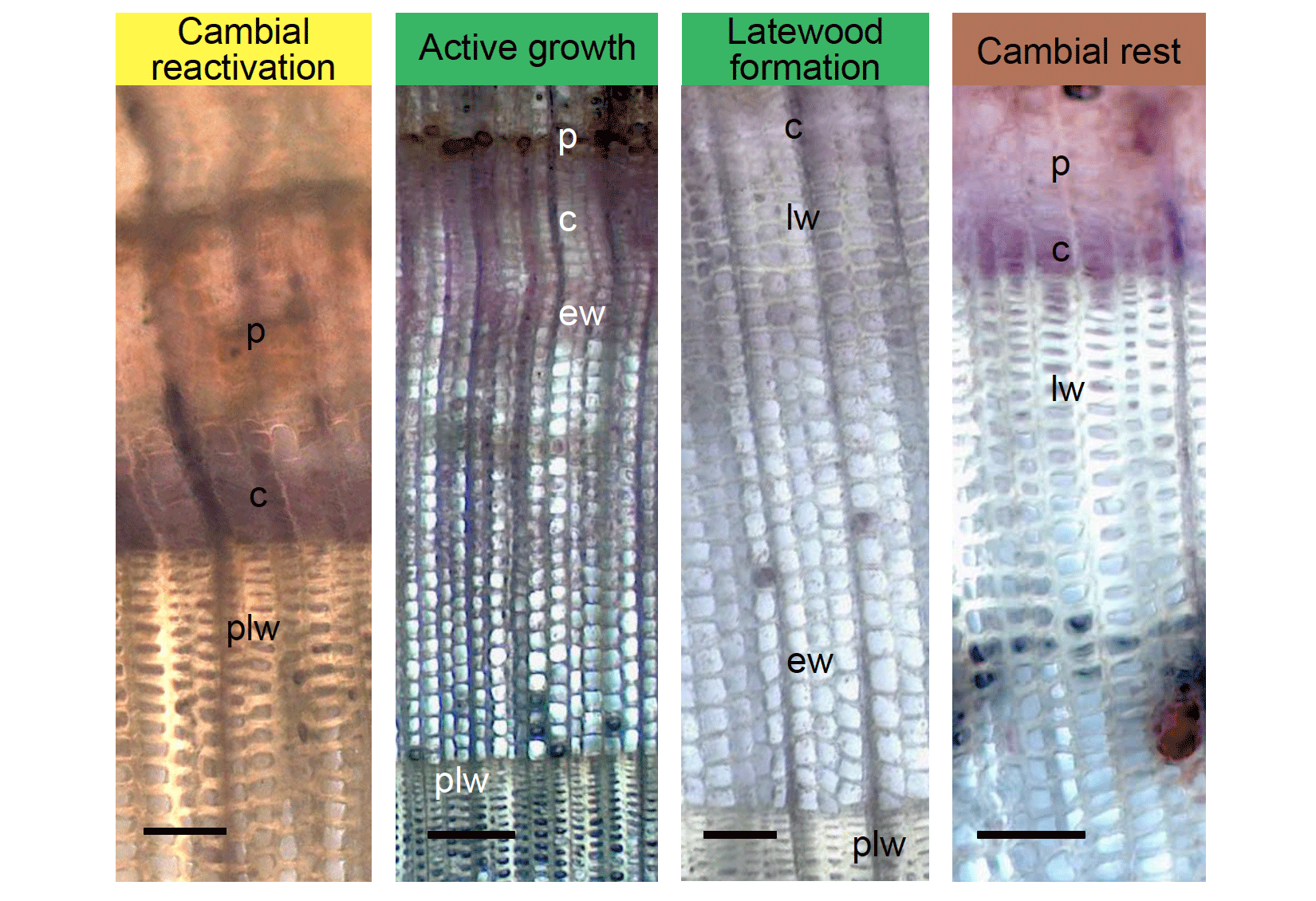博文
Plant Physiology:挪威云杉木材形成季节性转录图谱
||
�
Transcriptional roadmap to seasonal variation in wood formation of Norway spruce
First author: Soile Jokipii-Lukkari; Affiliations: Umeå Plant Science Centre (于默奥植物科学中心): Umeå, Sweden
Corresponding author: Hannele Tuominen
Seasonal cues influence several aspects of the secondary growth of tree stems, including cambial activity (形成层活性), wood chemistry (木材化学), and transition to latewood (晚材) formation. We investigated seasonal changes in cambial activity, secondary cell wall formation, and tracheid (管胞) cell death in woody tissues of Norway spruce (Picea abies) throughout one seasonal cycle. RNA sequencing was simultaneously performed in both the xylem and cambium/phloem tissues of the stem. Principal component analysis revealed gradual shifts in the transcriptomes that followed a chronological (按时间顺序的) order throughout the season. A notable remodeling of the transcriptome was observed in the winter, with many genes having maximal expression during the coldest months of the year. A highly co-expressed set of monolignol (木质素单体) biosynthesis genes showed high expression during the period of secondary cell wall formation as well as a second peak in mid-winter. This mid-winter peak in the expression did not trigger lignin deposition (木质素沉积), as determined by pyrolysis-gas chromatography/mass spectrometry (裂解-气相色谱/质谱法). Co-expression consensus network analyses suggested the involvement of transcription factors belonging to the AS2/LOB and MYB-HB families in seasonal control of secondary cell wall formation of tracheids. Interestingly, the lifetime of the latewood tracheids stretched (拉伸) beyond the winter dormancy period (冬季休眠期), correlating with a lack of cell death-related gene expression. Our transcriptomic analyses combined with phylogenetic and microscopic analyses (显微分析) also identified the cellulose and lignin biosynthetic genes and putative regulators for latewood formation and tracheid cell death in Norway spruce, providing a toolbox for further physiological and functional assays of these important phase transitions.
季节的变化会影响林木茎干次生生长的几个方面,包括形成层活性、木材的化学性质以及向晚材形成状态的转变。本文调查了在一整个季节循环中季节变化对于挪威云杉木质组织中的形成层活性、次生细胞壁形成以及管胞细胞死亡的影响。作者同时对茎干的木质部和形成层/韧皮部进行RNA测序分析。主成分分析显示了转录组在整个季节循环中存在时序的渐变。作者观测到了在一年中最冷的季节冬季某些基因达到其一年之中的最大表达表达量。一组高度共表达的木质素单体生物合成基因在次生细胞壁合成时高表达,其在仲冬时节出现第二次表达峰值。裂解-气相色谱/质谱研究显示仲冬时的表达峰值并不会诱导木质素的沉积。共表达网络分析表明AS2/LOB和MYB-HB家族的转录因子作用于管胞的次生细胞壁形成的季节性调控。有趣的是,晚材管胞在冬季休眠期之前完成延伸,这与细胞死亡相关基因表达缺失相关。作者结合转录组分析和进化及显微分析还鉴定了挪威云杉中纤维素和木质素生物合成相关基因,以及晚材形成和管胞细胞死亡可能的调控子,这些结果可以为进一步对这些重要的状态转变的生理和功能分析提供了候选目标。
通讯:Hannele Tuominen (https://www.umu.se/en/staff/hannele-tuominen/?expandaccordion=b)
�
研究方向:木质素组分的程序性死亡。
doi: https://doi.org/10.1104/pp.17.01590
Journal: Plant Physiology
First Published date: 27 February, 2018
(P.S. 欢迎关注微信公众号:微信号Plant_Frontiers)
https://blog.sciencenet.cn/blog-3158122-1101876.html
上一篇:the plant journal:二穗短柄草着丝粒DNA特性研究
下一篇:Nature Plants:植物天然抗病毒免疫与疾病恢复
全部作者的其他最新博文
- • Plant Physiology:CsMADS3促进柑果中的叶绿素降解和类胡萝卜素合成(华中农业大学)
- • Molecular Plant:LBD11-ROS反馈调节作用于拟南芥的维管形成层增殖和次生生长(浦项科技大学)
- • Science Advances:根结线虫通过调控植物的CLE3-CLV1模块,促进侵染进程(日本熊本大学)
- • Nature Communications:油菜素内酯参与植物营养生长期转变的分子机制解析(浙江农林大学)
- • Current Biology:光合作用产生的蔗糖驱动侧根“生物钟”(德国弗莱堡大学)
- • PNAS:花同源异型基因在叶中被抑制、花中被激活的分子机制(南卡罗来纳大学)

